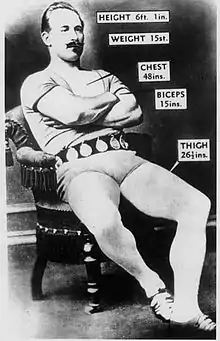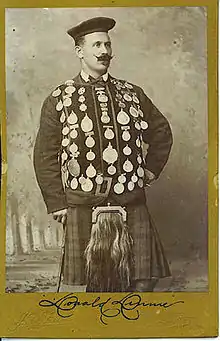Donald Dinnie
Donald Dinnie (1837–1916) was a Scottish strongman, born at Balnacraig, Birse, near Aboyne, Aberdeenshire.[1] He has been recognized as "The Nineteenth Century's Greatest Athlete".[2] Dinnie's athletic career spanned over 50 years, and over 11,000 successful competitions.
Donald Dinnie | |
|---|---|
 | |
| Born | Donald Dinnie 1837 |
| Died | 1916 (age 79) |
| Occupation | Highland Games Strongman |
| Height | 6 ft 1 in (1.85 m) |
| Competition record | ||
|---|---|---|
| Highland Games | ||
| Representing | ||
| Scottish Highland Games Championships | ||
| Champion | 1856 | |
| Champion | 1857 | |
| Champion | 1858 | |
| Champion | 1859 | |
| Champion | 1860 | |
| Champion | 1861 | |
| Champion | 1862 | |
| Champion | 1863 | |
| Champion | 1864 | |
| Champion | 1865 | |
| Champion | 1866 | |
| Champion | 1867 | |
| Champion | 1868 | |
| Champion | 1869 | |
| Champion | 1870 | |
| Champion | 1871 | |
| Champion | 1872 | |
| Champion | 1873 | |
| Champion | 1874 | |
| Champion | 1875 | |
| Champion | 1876 | |
Early life
The son of a stonemason, Donald Dinnie won his first sporting event, at the age of 16, in the nearby village of Kincardine O'Neil. He defeated the local wrestling strongman David Forbes, and took first place, winning £1 prize money.
Sporting career
Dinnie became an all-round athlete, growing and building his skills over a 21-year reign as Scottish champion (1856–1876). He excelled in sprint, hurdles, long and high jump, pole vault, putting the stone, hammer throw, tossing the caber and wrestling. The BBC website says "Comparing his best performances long before the Athens Olympics of 1896 leads one to imagine him capable of winning seven gold, a silver, and a bronze medal".[3] However, by 1896, Dinnie was approaching the twilight of his sporting career.
Dinnie was a 19th-century superstar, with widespread fame, success, and riches. Dinnie held the title "World Champion Wrestler", and was regarded as the "greatest athlete in the world",[4] and "The Strong Man of the Age".[5] He was so well known that "heavy artillery shells in the First World War were nicknamed 'Donald Dinnies'."[6] His documented achievements worldwide consist of "2,000 hammer throwing contests, over 2,000 wrestling matches, 200 weightlifting contests, and about 500 running and hurdle events. He also made a good living at all this, earning at least £25,000 in his career, a sum that would be worth about US $2.5 million today. And to this day his image continues to endorse commercial products in Scotland."[6]

Touring
As Scotland's greatest athlete, Dinnie competed in sixteen Highland Games seasons in his native land. He first toured the United States' Caledonian Circuit in 1870.[6] In that year he earned a fortune. Dinnie, then thirty-three, was titled "The Nineteenth Century's Greatest Athlete".[1] However, others despised and criticized Dinnie for his incredible strength. He continued to tour, and in his 60th year he was in New Zealand and Australia as a successful professional athlete.
Later years
Donald continued to be involved in theatres and at Highland Games as a judge, or in veteran events, until 1912. In 1903 Robert Barr invited him to endorse his soft drink Iron Brew, using Donald's image on the label with Donald proclaiming "I can recommend BARR's IRN BRU to all who wish to aspire to athletic fame, signed Donald Dinnie, All-round Champion Athlete of the World."[6] Later in Donald's life he struggled financially, and in his 70s was still performing as a strongman in London. His act was to support a platform made from a large table while two Highlanders danced a "fling" on it. Eventually London authorities terminated his performing licence because of his advanced age. To help with his situation, a benefit concert was organised which provided Dinnie with a small annuity.
Personal life
Donald and his family lived in Glasgow, where they owned a fish and chip restaurant and tea-room in the Govan area. They then lived for two or three years in Newcastle, England, before finally settling in London.
Death
Dinnie died in London in 1916, aged 78 years. In the United States, The New York Times paid tribute in the paper's obituary column.
Legacy
In 2002, Donald Dinnie was inducted into the Scottish Sports Hall of Fame in Edinburgh. Donald's relative Gordon Dinnie accepted a cut glass trophy on Donald's behalf. Gordon Dinnie also owned an original astrakhan breastplate that carries 19 medals won by Donald Dinnie from 1860 to 1896. A 23 inches (58 cm) carved statuette of Donald Dinnie, engraved with the words "Presented to Donald Dinnie, Champion Athlete In Appreciation of his Athletic Prowess, by his Scotch Friends, In Newcastle 1870", is in the Aberdeen Art Gallery along with many of Dinnie's medals.
The Dinnie Stones
In 1860, Dinnie undertook a feat of strength that was to give birth to a long-lasting legacy. He carried two granite boulders with a combined weight of 733 pounds (332 kg), now known as the Dinnie Stones, for a distance of more than 17 feet (5.2 m), across the width of the Potarch Bridge.[7] Each boulder had an iron ring fixed to it, to counterweight scaffolds from which workmen could repair the bridge, over the River Dee near Kincardine O'Neil.
As of August 2018, 90 men and three women have managed to lift the stones, and six men (including Donald and later his father) have carried them the full distance. The stones are now displayed outside the Potarch Café and Restaurant, on the south bank of the river by the Potarch Bridge.[8][9]
Lifting the Dinnie Stones (locally also "Stanes" and "Steens") remains a perpetual challenge. To claim a successful lift in the unassisted (without the aid of straps), a person must get wind beneath both stones to claim a full lift, and also full lock out the arms and legs.
The current record of holding them up unassisted is 41.00 seconds and was set in 21 January 2019 by Mark Haydock of Lancashire, England. On 7 September 2019, American strongman Brian Shaw set the new world record for continuously carrying the stones, which he did for 11 ft 6 1/2 inches.[10]
The first assisted lift by a woman was in 1979 by Jan Todd, with the first unassisted lift (without the aid of straps) in 19 January 2019 by Emmajane Smith.[8]
Titles
- World Champion Wrestler
- Scottish Champion, 1856–1876
- Strongest Man in the World
- Greatest Athlete in the World
References
- Drysdale, Neil (30 July 2014). "Was Donald Dinnie Scotland's greatest-ever athlete?". aberdeen.stv.tv.
- Zarnowski, Frank. "The Amazing Donald Dinnie: The Nineteenth Century's Greatest Athlete" (PDF). Iron Game History. 5 (1): 3–11. Retrieved 2 April 2009.
- "A Sporting Nation – Donald Dinnie". BBC. December 2005. Retrieved 22 June 2014.
- "Miscellaneous". The Sunday Times. Perth: National Library of Australia. 24 November 1912. p. 19 Section: Second Section. Retrieved 11 June 2014.
- "Advertising". The Sydney Morning Herald. National Library of Australia. 25 September 1884. p. 2. Retrieved 22 June 2014.
- "Donald Dinnie". A Sporting Nation. BBC. Retrieved 2 April 2009.
- Potarch Bridge was designed by Thomas Telford, is 200 feet (61 m) long with three spans, and was completed in 1813: "Potarch Bridge, over River Dee. LB3095". Historic Environment Scotland. Retrieved 8 August 2018.
- "The Dinnie Stones: the ultimate challenge". Retrieved 8 August 2018.
- Saner, Emine (8 August 2018). "A short guide to becoming seriously strong – by the woman who just lifted 332.5kg boulders". The Guardian. Retrieved 8 August 2018.
- Athey, Neil (6 June 2018). "World record Dinnie Stone lift smashed by strongman". Lancashire Telegraph. Retrieved 8 August 2018.
- Webster, David. "Reconsidering Donald Dinnie" (PDF). Iron Game History. 5 (2): 18–21. Retrieved 2 April 2009.
External links
- Rules of the Scottish-American Athletic Association
- Donald Dinnie entry at the Scottish Sports Hall of Fame
- Famous Scotland competitions and competitors
- stained glass window commemorating Donald Dinnie